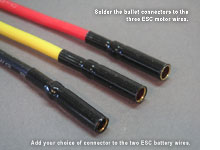
|
New to soldering bullet connectors? This will help:
YOUTUBE:
How to Solder Bullet Connectors - Innov8tive Designs
More videos on popular battery connectors:
YOUTUBE:
How to Solder a Deans Connector - Innov8tive Designs
YOUTUBE:
How to Install Anderson Powerpole Connectors
YOUTUBE:
Soldering XT60 Connectors
|